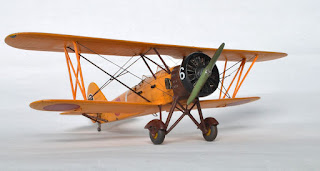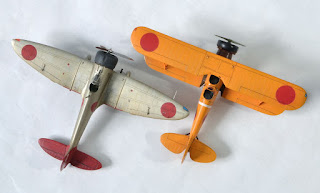Zbyszek Malicki from Poland very kindly shares these images of his special attacker Tachikawa Type 95 Chûren (an abbreviation for intermediate trainer) built from the RS Models kit in 1/72nd scale.


The model was built straight from the box with two exceptions. The windscreens were scratch built to replace the incorrectly rounded kit parts and the barrel in the rear cockpit was taken from the Hasegawa Isuzu Fuel Truck kit as this item is not provided in the RS Models kit. The decals are from the kit and represent aircraft # 9 of the 96th Shinbu-tai photographed at a civil flying school - the Kumamoto Local Pilot Training Centre - in 1945. This flying school was established in 1941 at a specially built airfield in the Kikukuchi district of Kumamoto Prefecture about 12 miles from Kumamoto City. It was also close to the Tachiarai Flying School branch airfield at Kuroishibaru on Kyushu. The Japanese characters beneath the five petal cherry blossom insignia on the tail appear to mean balmy (or summer) breeze (風薫 - kun fu - literally 'fragrant wind').


This aircraft's unit has sometimes been mis-identified in photo captions as the 21st Hikoshidan Shireibu Hikodan (sic). The 21st Hikoshidan (Air Brigade) was the parent formation for this and other units. Shireibu Hikohan (not Hikodan which means Air Division) was the Brigade headquarters flight, usually consisting of multi-engined transport aircraft although HQ staff officers sometimes flew fighter hacks and liaison aircraft like the Ki-51. The 21st Air Brigade had a number of units under command including two Ki-84 units - the 72nd and 73rd Sentai - and after Okinawa presided over the formation of special attack units such as this one in preparation for repelling expected Allied landing attempts on the Japanese mainland. For the paint scheme Zbyszek pre-shaded the model with black then applied an overall orange before the dark green camouflage. That was then skilfully 'weathered' to reveal glimpses of the underlying orange. Rigging was made using the fine nylon filament from pantyhose attached with superglue but Zbyszek notes this unusual technique requires a tricky combination of being gentle and fast!


The gasoline drum in the rear cockpit is presumed to be a makeshift explosive device and it is probable that the aircraft had been prepared for localised defence against Allied landing ships in anticipation of an invasion attempt on the mainland.
The Tachikawa Type 95-1 (九五式一 型練習機 - Kyu Go Shiki Ichi Gata Renshûki - literally 'nine-five type one form practice aircraft) was designed to a 1934 request from Army Air HQ after they had tested - and found too small - that company's private venture R-5 primary flying trainer. It existed in two versions - the Type 95-1 and Type 95-1 Kai, more commonly referred to as Ko and Otsu, the latter an improved version with a strengthened undercarriage, identifiable by the teardrop shared fairing at the intersection of the wheel struts. The Type 95 was operated throughout the war in the Renshū Hikōtai.
With special thanks to Zbyszek for sharing these images of his excellent model with Aviation of Japan.
Image credits: Model photographs © 2015 Zbyszek Malicki; Box art © 2009 RS Models




















